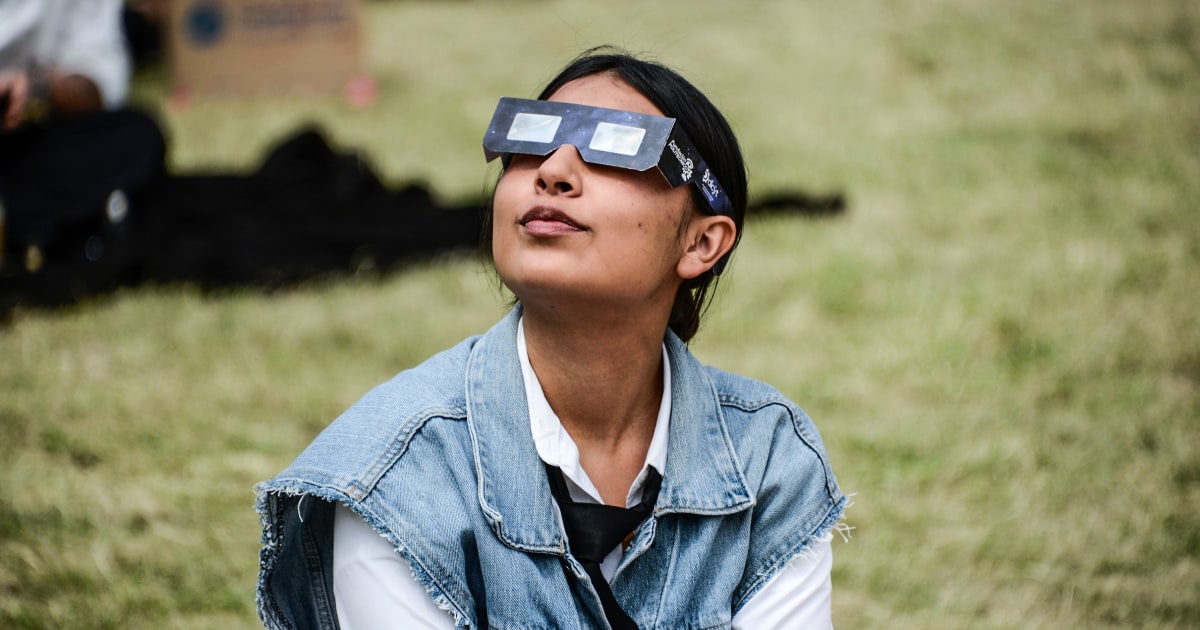
To view the spectacle safely, you can wear specialized glasses or build a pinhole projector. But do not try to view the eclipse through normal sunglasses or use tools like telescopes to watch it — even while wearing proper glasses — unless they are equipped with a special filter.
Here’s what to know.
How to find proper eclipse glasses
Glasses made specifically for looking at the sun offer the only safe way to view the eclipse directly.
“Eclipse glasses are very important to prevent photothermal injury to the retina, and not just any old glasses — they have to be eclipse glasses with the ISO 12312-2 filter,” said Dr. Nicole Bajic, a comprehensive ophthalmologist at the Cleveland Clinic Cole Eye Institute.
The glasses are “thousands of times darker” than sunglasses, according to NASA.
Without such precautions, watching the eclipse can cause permanent eye damage.
“It’s called solar retinopathy, and it’s damage to very sensitive, intricate cells that make up the retina, which is the lining of the back of the eye, and that’s what transmits light into electrical signals so that we can see what we see,” Bajic said. “And when we have damage from the sun to that tissue, we can get decreased vision and central blind spots in our vision.”
When and how to wear your glasses
The only safe moment to look at the eclipse with the naked eye is “when the moon completely obscures the sun’s bright face — during the brief and spectacular period known as totality,” according to NASA, which adds: “You’ll know it’s safe when you can no longer see any part of the sun through eclipse glasses or a solar viewer.”
Chris Hartenstine, the public engagement lead for NASA’s Glenn Research Center in Cleveland, Ohio, said it will be clear when totality has arrived.
“When you’re wearing the eclipse glasses and you look up at the sun, you will, even on the slightest sliver, you will see the glow of the sun on the edge of that disc,” he said. “When that is completely out, give yourself another couple of seconds and then you can take them off.”
Totality will last around three-and-a-half to four minutes, depending on the location, according to NASA.
Those viewing a partial eclipse must keep their special eclipse glasses on throughout.
And the glasses are not sufficient for people who want to use tools like binoculars or cameras.
“Viewing any part of the bright sun through a camera lens, binoculars, or a telescope without a special-purpose solar filter secured over the front of the optics will instantly cause severe eye injury,” NASA warns.
How to ensure your glasses are safe
NASA does not approve any particular brand of solar viewers, but it points to the American Astronomical Society’s list of safe options and recommends avoiding online marketplaces where third-party vendors could be selling knockoffs or poorly handled products. The society warned last week that fake and counterfeit glasses “are polluting the marketplace.”
“The fewer hands that need to trade places between the time that they were produced and the time they’re in your hands would help to increase your chances that you haven’t gotten some type of poor or less than desirable product,” Hartenstine said.
Reusing eclipse-viewing glasses is also an option if you were one of the millions who took in 2017’s solar eclipse and held on to your pair.
“The filters, the actual lenses are good indefinitely,” Hartenstine said, though he added that you should make sure the lenses haven’t been damaged, including with scratches, punctures or crinkling.
“If you’re not certain, obviously get a new pair. But the expiration dates, just because they’re printed on the glasses, are not pertaining to ISO standard solar filter material,” Hartenstine said.
How to make and use a pinhole projector
If you can’t find proper glasses, you can enjoy the eclipse without looking directly at it by making a pinhole projector.
The device works by letting in sunlight through a small hole, focusing it and projecting it onto a piece of paper, wall or other surface to create an image of the sun that is safe to look at.
To make a projector, cut a 1- to 2-inch square or rectangle out of the center of a piece of plain white paper or white cardboard. Tape a piece of aluminum foil over that cut-out shape, then use a pin or thumbtack to poke a tiny hole in the foil. Use a second piece of white paper or cardboard as the screen onto which the projected image will appear.
To use your projector, place the paper screen on the ground, stand with the sun behind you, and hold your device with the foil facing up. Make sure to only view the projected image of the eclipse, rather than looking at the sun. Adjusting how far you hold the projector from the screen will change the size of the resulting image.
A colander or other household item with small holes in it can be used the same way, and sturdier projectors can be made with cereal boxes.
Even simpler: Find a shady tree and look at the ground underneath it — you’ll likely see crescent-shaped shadows.






